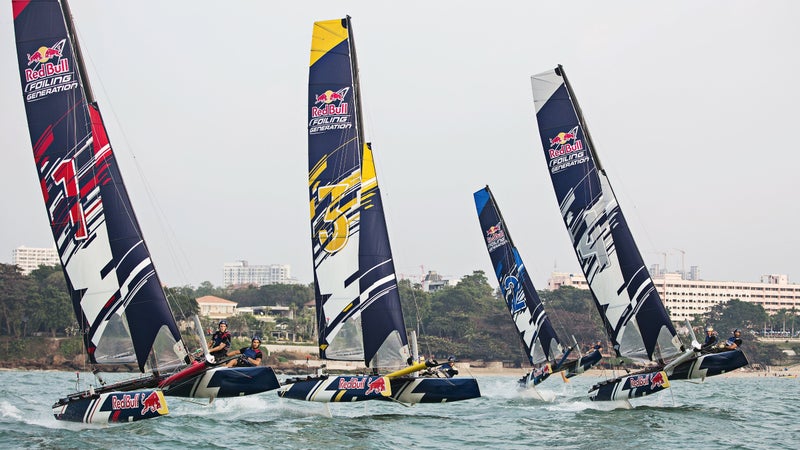On May 9, 2013, British Olympic sailor Andrew Simpson was on a training run for the 34th America’s Cup off the California coast when his catamaran capsized while turning around downwind, or gybing. During that maneuver, large catamarans are liable to dig a hull into the water and pitch-pole, essentially somersault. He was sailing an AC72, a 72-foot-long, carbon-fiber vessel capable of hitting 55 mph.��
Such high-speed capsizes are thrilling to watch, and fatal accidents are extremely rare. But in Simpson’s case, the yacht he was crewing broke apart and he died in the water, trapped under the wreckage. The accident, the fifth death in the race’s 164-year history, caused race officials to lower the max wind speed in which a race can be held. The precaution was an attempt to control the environment in which these boats race—to provide control that the design inherently doesn’t because of the enormous power of the 130-foot rigid wing.
“By going to catamarans we tried to make sailing a bit more extreme, friendlier for the viewing audience,” Oracle Cofounder Larry Ellison said at the on September 25, 2013. Ellison designed the AC72. “A lot of people weren’t interested in sailing, and now they are. This regatta has changed sailing forever.”

Whether a natural evolution, dangerous, or both, the current state of competitive sailing is undergoing a paradigm shift. Even though the America’s Cup now has an effective speed limit, most races and competitions don’t. Also, historically, a race course was tens of miles, which allowed boats a certain margin of space. But in addition to the boost in speed, the race courses are becoming shorter: they’re now only two or three miles long, which means competitors jockey for position in a smaller space. This means more interaction between boats and opportunities for collisions. Taking it even further, Red Bull is now bringing this high-stakes style of sailing to younger, potentially more inexperienced sailors.��
The energy drink and extreme sports empire announced March 4 that two Olympic champions and members, Roman Hagara and Hans Peter Steinacher, have begun searching for sailors ages 16-to-20 to fill the roster of a new race circuit they will direct, called . The new global competition will feature races involving four class catamarans, which the men designed to fly on hydrofoils at speeds of 40 mph.
Flying Phantoms are a fraction of an AC72’s weight and risk. But racers will receive only two days of coaching and practice on the $40,000 vessels, Red Bull announced. Candidates must have��experience racing skiffs or other catamarans, and be “extremely well-prepared, technically and physically,” Steinacher .��Each of the 18-foot-long, 155-kg boats, piloted by two people and capable of hitting “speeds unheard of��a few months ago,”��will compete in a “knockout” style race, with two boats qualifying for a next round. The races will be quick—20-to-25 minutes—like the America’s Cup. Seven events all over the world will be televised on a��.
“It’s going to be really good racing,” Kotoun said. “It’s gone from a golf mentality to a moto-cross mentality.”
“There’s a lot of danger involved, especially when you’re foiling on trapeze,” which is that tenuous position in which sailors are suspended by a wire, standing off the side of a hull, says professional sailor Anthony Kotoun. He added that the stadium-style racing is like “a bunch of NASCAR cars going around a turn.”
There’s never been a conduit to train teen amateurs in this style of sailing.��Professionals have traditionally been in their 30s and 40s—sailors with experience��at the collegiate, national, world, and��Olympic levels.��Red��Bull held the first Youth America's Cup��(also directed by Hagara and Steinacher) in 2013, on catamarans without foils, and participants were national team sailors ages 19 to 23. The����demonstrated the popularity of the sport among young sailors.��The Foiling Generation series will give amateurs the intense racing experience needed to get noticed. But��the learning curve could have consequences.
Racing these cats requires lightning-quick reflexes. Kotoun, though he considers himself a “safety nerd,” fears the combination of a lack of experience, the potential for a trapeze to snap, and the presence of fast-moving hydrofoils in the water. The hydrofoils are like “samurai swords slicing through the water,” he says.��“It’s going to be really good racing,” he says. “It’s gone from a golf mentality to a moto-cross mentality.”
Red Bull says the circuit will be a clear-cut path to professional sailing for young racers. “I am always looking for the most exciting and challenging parts of the sport,” Steinacher told�������ԹϺ���.��“The most important expectation is to find the best talented sailors on planet Earth.”��But the race, which will begin April 17 in Japan, is also clearly following Ellison’s lead in upping the stakes in sailing.
��“I think the America’s Cup showed us that this can be a dangerous endeavor,” says����Gino Morrelli, who designed the��, a major Flying Phantom competitor. “I think [multihull racing] is going to turn into a sport that requires this protective gear. It's going to get that extreme sport mentality. We’re like the Wright Brothers—we’re going to crash a few planes before we get this right.”


